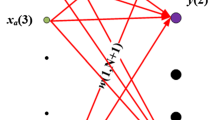Abstract
A new method and a supporting theorem for designing multiple-class piecewise linear classifiers are described. The method involves the cutting of straight line segments joining pairs of opposed points (i.e., points from distinct classes) ind-dimensional space. We refer to such straight line segments aslinks. We show how nearly to minimize the number of hyperplanes required to cut all of these links, thereby yielding a near-Bayes-optimal decision surface regardless of the number of classes, and we describe the underlying theory. This method does not require parameters to be specified by users — an improvement over earlier methods. Experiments on multiple-class data obtained from ship images show that classifiers designed by this method yield approximately the same error rate as the bestk-nearest neighbor rule, while providing faster decisions.
Similar content being viewed by others
References
CHANG, C. L. (1974), “Finding Prototypes for Nearest Neighbor Classifiers,”IEEE Transactions on Computers, C-23, No.11, 1179–1184.
COVER, T. M., and HART, P. E. (1967), “Nearest Neighbor Pattern Classification,”IEEE Transactions on Information Theory, IT-13, 21–27.
DEVIJVER, P. A., and KITTLER, J. (1980),Pattern Recognition, A Statistical Approach, Englewood Cliffs, NJ: Prentice Hall.
DUBOIS, S. R., and GLANZ, F. H. (1986), “An Autoregressive Model Approach to Two-Dimensional Shape Classification,”IEEE Transactions on Pattern Analysis Machine Intelligence, PAMI-8, No.1, 55–65.
DUDA, R. O., and HART, P. E. (1973),Pattern Classification and Scene Analysis, New York: Wiley.
DUDANI, S. A., BREESING, K. J., and MCGHEE, R. B. (1977), “Aircraft Identification by Moment Invariants,”IEEE Transactions on Computers, C-26, No.1, 39–45.
FORGY, E. W. (1965), “Cluster Analysis of Multivariate Data: Efficiency Versus Interpretability of Classifications,”Abstracts in Biometrics 21, No.3, 768. (Biometric Society Meetings, Riverside, CA)
GOWDA, K. C., and KRISHNA, G. (1979), “The Condensed Nearest Neighbor Rule Using the Concept of Mutual Nearest Neighborhood,”IEEE Transactions on Information Theory, IT-25, No.4, 488–490.
HART, P. E. (1968), “The Condensed Nearest Neighbor Rule,”IEEE Transactions on Information Theory, IT-14, No.3, 515–516.
HU, M. K. (1962), “Visual Pattern Recognition by Moment Invariants,”IEEE Transactions on Information Theory, IT-8, No.2, 179–187.
JACOBY, S. L. S., KOWALIK, J. S., and PIZZO, J. T. (1972),Iterative Methods for Nonlinear Optimization Problems, Englewood Cliffs, NJ: Prentice Hall.
KASHYAP, R. L., and CHELLAPPA, R. (1981), “Stochastic Models for Closed Boundary Analysis: Representation and Reconstruction,”IEEE Transactions on Information Theory, IT-27, No.5, 627–637.
MANGASARIAN, O. L. (1968), “Multisurface Method of Pattern Separation,”IEEE Transactions on Information Theory, IT-14, No.6, 801–807.
SANTIAGO, H. L. (1983),Computer-Aided Design of Multiple-Class Piecewise Linear Classifiers, M.S. Thesis, Pattern Recognition Project, School of Engineering, University of California, Irvine.
SKLANSKY, J., and MICHELOTTI, L. (1980), “Locally Trained Piecewise Linear Classifiers,”IEEE Transactions on Pattern Analysis Machine Intelligence, PAMI-2, No.2, 101–111.
SKLANSKY, J., and WASSEL, G. S. (1981),Pattern Classifiers and Trainable Machines, New York: Springer-Verlag.
TAKIYAMA, R. (1980), “A Learning Procedure for Multisurface Method of Pattern Separation,”Pattern Recognition, 12, 75–82.
TOMEK, I. (1976), “Two Modifications of CNN,”IEEE Transactions on Systems, Man and Cybernetics, SMC-6, No.11, 769–772.
WILSON, D. (1972), “Asymptotic Properties of Nearest Neighbor Rules Using Edited Data,”IEEE Transactions on Systems, Man and Cybernetics, SMC-2, 408–421.
Author information
Authors and Affiliations
Additional information
This research was supported in part by the Army Research Office under grant DAAG29-84-K-0208 and in part by the University of California MICRO Program. We thank R. W. Doucette of the U.S. Naval Weapons Center and R. D. Holben of Ford Aerospace Corporation for providing the ship images in our experiments.
Rights and permissions
About this article
Cite this article
Park, Y., Sklansky, J. Automated design of multiple-class piecewise linear classifiers. Journal of Classification 6, 195–222 (1989). https://doi.org/10.1007/BF01908599
Issue Date:
DOI: https://doi.org/10.1007/BF01908599




